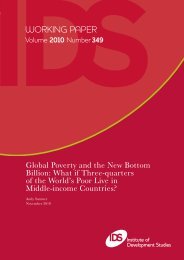1 'Troubling race. Using Judith Butler's work to think about racialised ...
1 'Troubling race. Using Judith Butler's work to think about racialised ...
1 'Troubling race. Using Judith Butler's work to think about racialised ...
Create successful ePaper yourself
Turn your PDF publications into a flip-book with our unique Google optimized e-Paper software.
with the African-American ac<strong>to</strong>r Samuel L. Jackson <strong>about</strong> how unlike black characters,<br />
white characters in films are not defined by their whiteness, they just ’happen <strong>to</strong> be white’,<br />
Samuel L. Jackson’s response is striking: Hattens<strong>to</strong>ne writes that "Jackson laughs so loud<br />
that, when I'm playing back the tape on headphones a colleague jumps. 'That's what you<br />
<strong>think</strong>. You just dismiss the fact they're white'". Thus invisibility of whiteness is, at least in<br />
part, a fantasy in the minds of white people.<br />
Visibility or invisibility are mediated by power. The consequences of either depends on<br />
one’s position within normative regimes. This is illustrated by the many different ways in<br />
which visibility and invisibility is written <strong>about</strong>. As Dyer and others writing <strong>about</strong><br />
whiteness point out, racial invisibility can potentially ensure the endurance of a position<br />
of privilege and power. While whiteness remains unmarked, it stays unchallenged. This<br />
means that white people are visible as individuals, but unmarked as a racial group - at<br />
least <strong>to</strong> themselves and within normative discourses. But invisibility can also mean<br />
marginalisation - for example the writer Yasmin Alibhai-Brown refers <strong>to</strong> the “growing<br />
invisibility of Asians” in the media industry (Alibhai-Brown 1998), or one might discuss<br />
the invisibility of <strong>race</strong> of black people in white people’s accounts. This raises the question<br />
of the relationship <strong>to</strong> normative discourses and links <strong>to</strong> Butler’s discussion of subject and<br />
abject. For Butler, the normative position of subject is defined by, and dependant for its<br />
position on what is excluded, its ‘constitutive outside’. The subject comes in<strong>to</strong> being<br />
through a process of identifications formed through the “repudiation which produces a<br />
domain of abjection, a repudiation without which the subject cannot emerge” (Butler<br />
1993, p3). In terms of the heterosexual norm, the other is the homosexual. However this<br />
is not the only ‘abjected’ position. For instance Butler discussed the representation of<br />
Turkish refugees in the German press:<br />
“But no Turk has a complex family or psychological his<strong>to</strong>ry that Die Zeit ever writes<br />
<strong>about</strong>, or at least not that I have seen in my reading of this material. So, we get a kind of<br />
differential production of the human or a differential materialization of the human. And<br />
we also get, I <strong>think</strong>, a production of the abject. So, it is not as if the un<strong>think</strong>able, the<br />
unliveable, the unintelligible has no discursive life; it does have one. It just lives within<br />
discourse as the radically uninterrogated and as the shadowy contentless figure for<br />
something that is not yet made real.” (Costera Meijer and Prins 1998, p281)<br />
Visibility and invisibility also raise the question of the acts of seeing and looking. It is<br />
this question which I will examine through analysis of some of the interview material.<br />
Patricia Williams (Williams 1997) writes of the tensions around <strong>race</strong>, the ‘forbidden<br />
gaze’ of <strong>race</strong> and what one is are ‘cultured <strong>to</strong> see or not see’. To see or not <strong>to</strong> see ‘<strong>race</strong>’ or<br />
difference is a political act and one which, as the interview material shows is riven with<br />
doubts and confusion fro the white people I interviewed. In the interviews I under<strong>to</strong>ok for<br />
the research, the issue of ‘seeing’ <strong>race</strong> or colour came up when I asked the mothers<br />
whether they thought their children (both pre-school and primary school age) had any<br />
understanding of ‘<strong>race</strong>’. This question was designed <strong>to</strong> prompt the women <strong>to</strong> talk in a<br />
6

















